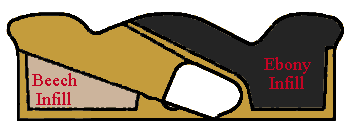
What makes a fine shoulder plane |
| Dovetailed Steel construction
versus a Bronze casting The earliest metal planes were made by dovetailing
wrought iron plates together to form a plane body which was then fitted with wooden
insides. Hence the name "Infill". The metal sole minimized wear and enabled a
very fine mouth, both essential attributes of a fine plane. The wood infill dampened
vibration. Many manufacturers made infill metal planes in a variety of styles from about
the 1840's to the 1940's. Among the largest were Spiers, Mathieson, Slater, Norris, and
Preston There are two basic ways of making an infill plane. The body must either be dovetailed together from steel plates or formed from a casting. In the former method three steel plates are joined by cutting dovetails and then forging the sides and sole together. This produces a carcass that won't warp from casting stress, but it requires a tremendous amount of skilled labor. The other way is to cast the body out of either malleable iron or bronze. This simplifies the situation but casting will have a tendency to warp, so care has to be taken. Gunmetal bronze wears, so it was usual in the better planes to solder a steel sole onto the body to give a hard wearing surface to the sole. This also meant that it was stronger and it was easier to make a fine mouth. In both cases the finished body is then stuffed with hardwood, usually rosewood, but ebony and other dark tropical woods were used. Aside from the obvious differences of construction between infill shoulder planes and the Preston cast iron design, a major difference is that on Norrises any space under the blade that is not part of the body casting is filled with wood (beech). On Preston shoulder planes this space is empty. |
 |
| The fine mouth A fine mouth is essential for a great trimming plane. In a shoulder plane, with the blade bevel up, the mouth only has to be wide enough for a tiny bit of blade to stick out and for thin shavings to pass. The extra bit of plane bed supporting the blade as close to the cutting edge as possible reduces vibration, and the fine mouth keeps a newly formed shaving of wood from splitting ahead of the blade. The former feature helps keep a consistent cut which improves the final surface and the latter feature reduces tearout. Flatness of the sole A second major factor is the flatness of the sole. Dovetailed steel planes in good condition are very flat, any concavity being formed by either extensive wear or misuse. However, it is routine to find steel soled bronze planes with a slight concavity of the sole. It is not known whether the concavity is the result of stress released in the steel bronze body over a long time or whether the tools warped shortly after leaving the factory. Proper fitting of the wedge A wedge that truly locks the blade in place all along the body of the plane, especially near the mouth, is carefully fitted. A properly fitted blade will be only slightly wider (.01") than the shoulder plane body. With one exception the infill shoulder planes were not made with adjusters but as most planes of the time didn't have adjusters, this wasn't at all unusual or a great problem for the user. |
Copyright 1999 01 Inc., NYC